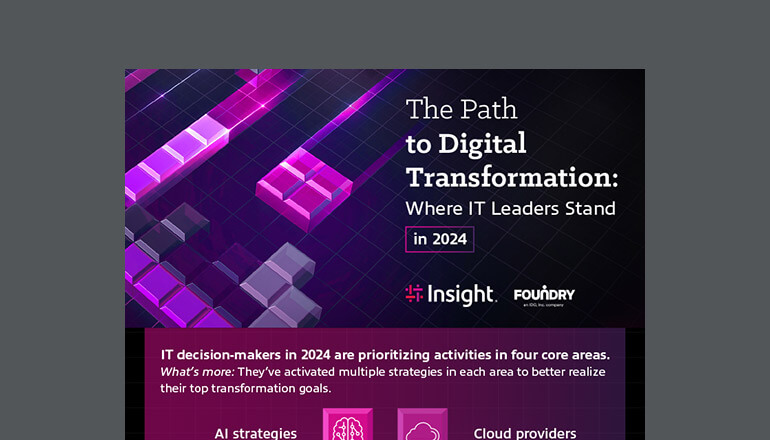Article How to Prepare for the Move to Office 365
Your IT team are the best-of-the-best. They’re the dream-team that are fully engaged with all levels of your business and love what they do - keeping your employees productive.
By Insight Editor / 29 Sep 2018 / Topics: Microsoft 365 Modern workplace Cloud Software

But while they’re confident and comfortable with solving day-to-day IT problems with servers, networks or devices, any talk of digital transformation or migration towards modern workplace technologies like Office 365 or even Microsoft 365 unnerves them.
Conversations with management
You can almost imagine the conversation between management and IT going something like this:
Management: “We need to modernise our IT systems and move to Microsoft Office 365.”
IT: “Where do we start? Which IT systems do we move first? Should we do a full migration or take a stepped approach? Do we move everyone or just some pilot users?”
Management: “The move looks pretty straightforward – just take emails and files and place them in the “Office 365 cloud” - you guys love a challenge...”
IT: “If only it were that simple.”
Complexities and challenges
And that is the reality - migrating to Office 365 is complex and carries challenges that differ from traditional technology migration activities. As with most businesses, you probably have a range of existing platforms, databases and legacy infrastructure – and perhaps different versions of software used across your departments. Getting all of this data into the Office 365 cloud is no mean feat.
While IT provide ongoing support to your users, more time, money and expertise are needed to get your traditional applications to run in the cloud. The bad news is, even though you have IT rock stars, they have limited resources to both manage and transform the business at the same time. The good news is, when done correctly, migrating to Office 365 boosts your employees efficiency with the latest productivity and collaboration tools, giving your workforce greater workplace flexibility. At the same time the IT infrastructure burden and support costs are reduced. Win-win right?
Office 365: 7 steps to salvation
Whether this is your first or latest Office 365 migration project, following these 7 basic steps will help smoothen your migration journey with no disruption for users or to your business.
1. Making preparations
Without a doubt, this is the most important and tedious part of the migration project. Gather all the information about your current systems, workflows, usage scenarios, and processes. Then align them with your business goals to understand how they will complement your modern workplace strategy. Take time to digest the information as it will prove invaluable during the actual migration process.
2. Plan, plan, plan
The findings from Phase 1 will arm IT with everything they need to create a comprehensive migration plan highlighting potential risks and a robust action plan to deal with any issues that could arise. This readiness assessment will help IT draft a design and rollout plan with key migration tasks, dates and milestones including user adoption and training. Remember it’s vital to get this right – without a solid plan, resolving problems during a migration can quickly drain IT resources and significantly disrupt business, so take your time.
3. Setup your service
Now, IT is ready to setup Office 365, configure Azure Active Directory (AAD), Active Directory Federation Services (ADFS) and establish the basic services required to provide authentication to your Office 365 Services.
4. Smooth migration
With knowledge gained in the preparation phase, IT can decide how to roll out Office 365 and more importantly ensure users get all their emails, files and content. Keep in mind that Office 365 is a diverse set of services, so IT will need to migrate services individually. For example, when they migrate a user’s inbox to Office 365, only the inbox will get moved. The user’s calendars will not move until they are migrated separately. They’ll need to tick off everything on the Office 365 checklist before they go ahead with the migration.
5. All aboard
Some Office 365 applications have different interfaces and work in a different way compared to traditional Office or productivity apps. This is why users must receive proper onboarding and training so that they can work effectively. Once they’re comfortable with the basics, concentrate on training users to use all of the new features and tools at their disposal. This will help you get the most value and return on investment when it comes to your Office 365 migration.
6. Not over till it’s over…
The work isn’t quite finished once all users are moved on to Office 365…. Your IT team will need to consider new admin plans, monitoring, strategy, auditing and archiving to ensure that you’re covered for the long-run..
7. Find a trusted Microsoft Partner
You can migrate to Office 365 in-house as described above. However, not every IT team is confident enough to do this or has the time and resource available. In which case you can turn to an experienced Microsoft partner and engage them from the very start. Your IT partner can help with everything from migration preparation and planning to performing the migration and purchasing the right Office 365 service plan best suited for your business.
Moving to Office 365 requires careful consideration for a lot of moving parts: access to email, stored information, devices, communication and collaboration tools must all work together to enable a modern workplace experience for your users. If you’re ready to make the move to Office 365, Insight's Migration services could be just what you need to make a smooth and effective transition.


